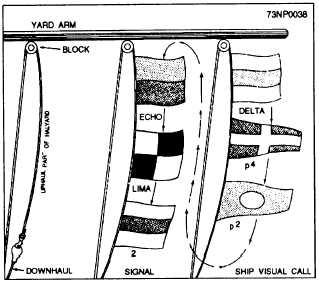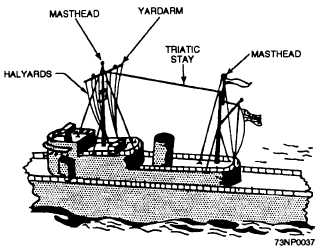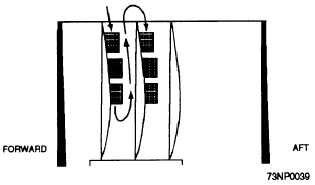More information on the hoisting of flaghoist
signals is contained in ACP 129.
READING FLAGHOISTS
It is not enough to know every flag and pennant
by sight; you have to read flags in their proper
sequence to interpret their meaning correctly.
When several flaghoists are displayed
simultaneously, they are read in the following order:
masthead, triatic stay, starboard yardarm, and port
yardarm. Locations of halyards vary on ships because
superstructure characteristics differ. Figure 5-4 shows
the locations.
You should read flags of a single hoist from the
top down. If a signal flown on a yardarm is divided
into more than one hoist, read from the top down and
from outboard in, as in figure 5-5. A flaghoist that is
to be read before another that is flying at the same time
may be described as being in a superior position. If a
flaghoist is to be read after another, it is referred to as
being in an inferior position.
Read flags hoisted at the triatic stay from forward
to aft. (See fig. 5-6.)
FLAGHOIST ESSENTIALS
Strive for the following essentials in flaghoist
signaling:
1. Always bend on the correct flag.
2. Hoist rapidly and smoothly.
Figure 5-4.—Flaghoist locations.
Figure 5-5.—Reading a flaghoist.
3. Send all flags up clear, unfouled by rigging or
by themselves.
4. Haul down signals sharply and smoothly,
without allowing them to stream to leeward or over the
side.
5. Restow flags rapidly and accurately so you are
ready for the next signal to be made.
FLAG BAG OPERATIONS
The day will soon come when it is your turn to
stand in front of the flag bag and bend on the flags.
You should know the flag bag so well that you can
close your eyes and still come close to hitting the slot
where a particular flag is stowed. The ability to bend
Figure 5-6.—Reading a flaghoist at the triatic stay.
5-5






